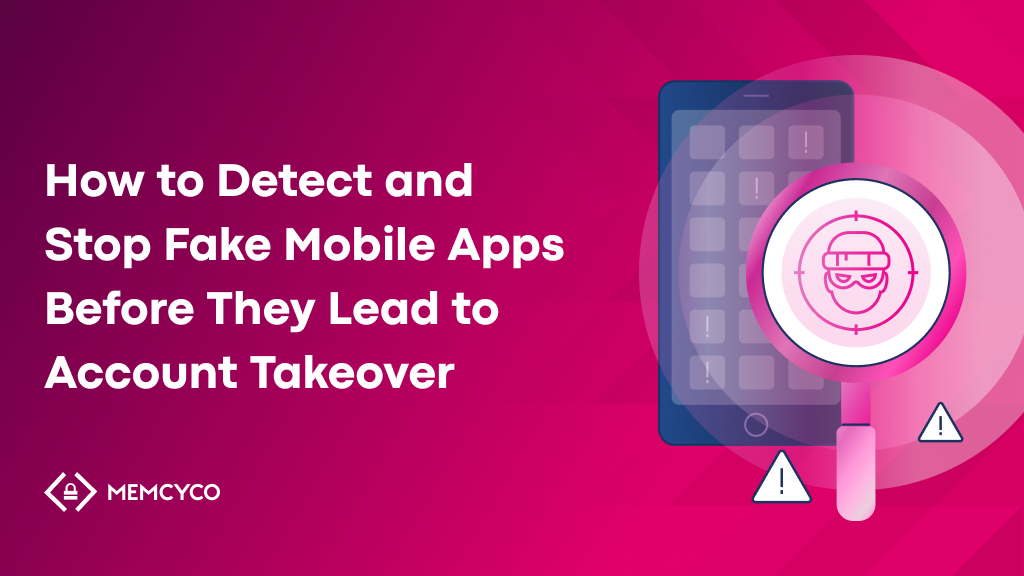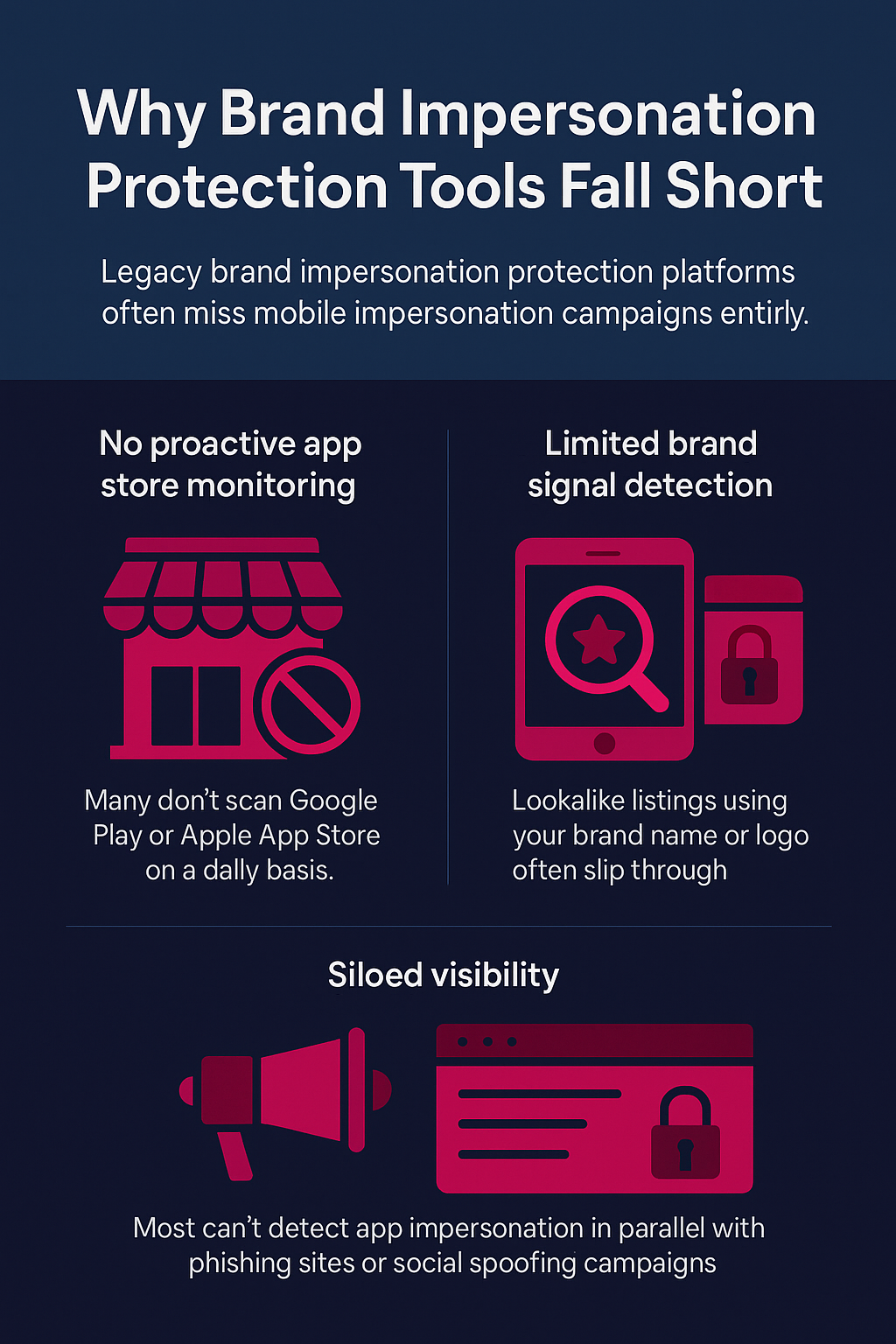Fake apps are the latest evolution of brand impersonation, and they’re proving just as dangerous as phishing sites. Fraudsters clone legitimate mobile apps, publish them on official app stores, and trick users into entering credentials — which are then reused in the real app before anyone notices. Given that over 60% of web traffic is now mobile, this form of phishing-driven credential reuse has become one of the top blind spots in mobile fraud defense. Yet most mobile security tools can’t detect it — because they don’t know where those credentials came from.
How Fake Apps Enable Credential Reuse
Mobile app account takeover occurs when an attacker gains unauthorized access to a user’s account through the mobile app interface – usually by leveraging stolen credentials. These credentials are often collected through phishing, credential stuffing, or breaches in other channels and then reused to access accounts in the mobile environment.
Attackers don’t just send phishing links anymore. Today, they build full-blown fake apps and submit them to app stores, often using cloned UI and stolen branding. Users download them thinking they’re real and submit login credentials that are immediately harvested. From there, those credentials are reused in the real mobile app, enabling stealth ATO without triggering alerts.
Why Mobile App Impersonation Is a Growing Threat
Mobile apps now account for over 55% of total digital engagement, while 60% of web traffic comes from mobile browsers – highlighting the dominance of mobile across both native apps and web channels. Attackers increasingly publish fake apps in official app stores that closely mimic trusted brands — not just in appearance but in function. These impersonating apps are often promoted through search ads, social media, or app store recommendations, making them dangerously easy to find and download.
This fragmentation is particularly dangerous in high-value industries:
- Banking apps give attackers direct access to funds and account data.
- Retail and e-commerce apps often store loyalty points, saved cards, and one-click purchasing capabilities – ideal for fraud monetization.
- Travel and airline apps allow for itinerary changes, miles redemption, and personal data access, leading to both financial loss and customer churn.
The most common mobile ATO pathways include:
- Phishing sites optimized for mobile that trick users into submitting credentials
- Brand impersonation via fake app listings or social campaigns
- Credential reuse from previously phished or leaked logins
- Automated credential stuffing attacks targeting mobile login APIs
Given the overlapping threats, detecting and stop credential reuse attacks where they converge – at the point of login in the legitimate mobile app – is arguably the only scalable solution. Embracing that reality means first moving away from outdated approaches.
How Fake Apps Evade Traditional Defenses
Most app impersonation attacks exploit systemic gaps in mobile trust channels:
-
Limited store vetting – App stores miss cleverly disguised listings that use brand-adjacent names or subtle UI cloning.
-
Visual deception – Attackers replicate logos, UX elements, and even developer names.
-
Ad promotion – Many fake apps gain traction through paid search ads using typos, keyword stuffing, or trademark misuse.
-
User trust in app stores – Users assume apps in official stores are vetted and safe — which makes spoofing particularly effective.
Even a single impersonating app can cause massive reputational damage, account takeovers, and financial losses before anyone notices.
Where Traditional Brand Protection Tools Fall Short
Legacy brand impersonation protection platforms often miss mobile impersonation campaigns entirely. Here’s why:
-
No daily app store scans – Most don’t monitor Google Play or Apple App Store proactively.
-
Blind to app metadata abuse – Keyword stuffing, category spoofing, and logo cloning are rarely flagged.
-
No cross-channel linkage – They can’t connect a fake app campaign to simultaneous phishing sites or social ads.
By the time a user reports a fake app, the damage is already done — often at scale.
Memcyco Detects App Impersonation Before Damage Is Done
Fake apps don’t just appear out of nowhere, they leave digital fingerprints. Memcyco monitors official app stores, social media, and referral patterns to detect unauthorized app listings, brand elements or naming schemes that mimic your legitimate app, and spoofed download campaigns impersonating your brand. This early warning lets you act before users are tricked, and before stolen credentials are used in your real app.
How Memcyco Detects Credential Misuse Triggered by Fake Apps and Phishing Sites
Whether credentials are phished through fake apps, spoofed websites, or malicious ads, Memcyco detects their misuse the moment attackers try to use them in the real app.
Memcyco’s agentless, real-time solution detects and mitigates credential misuse in real-time across mobile and web by detecting session anomalies, suspicious referrals, and decoy credential replay patterns.
Real-Time Credential Misuse Detection
- Detects stolen credentials replayed in legitimate apps, even if harvested through fake apps or spoofed mobile sites
- Flags login attempts from devices that interacted with known impersonation campaigns or phishing infrastructure
- Surfaces correlated login signals by combining session behavior, referral patterns, and decoy credential replay, revealing misuse tied to phishing and impersonation campaigns.
Related: How to Detect and Stop Reverse Proxy Phishing Attacks in Real-Time
Decoy Credential Injection
- Replaces credentials entered on phishing sites or fake mobile apps with decoys
- Detects decoy replay attempts inside real mobile login flows
- Reveals compromised sessions tied to specific devices or campaigns
Device Fingerprinting
- Tracks login behavior across known and unknown devices
- Flags reused or suspicious device fingerprints, even in clean sessions
Backend Login Telemetry
- Analyzes login attempts in real time via API integrations
- Detects credential stuffing, brute force, and credential anomalies without SDKs
All of this happens invisibly and seamlessly with no app changes or impact on user experience. In other words, Memcyco delivers high-fidelity login signals, enabling preemptive intervention options, without requiring in-app instrumentation.
Read more: How Browser-Level Signals Help Prevent Credential Stuffing Attacks
Why Memcyco Has Leading Analysts Paying Attention
Memcyco was recognized in Datos Insight’s Q1 2025 Fintech Spotlight for its innovative approach to phishing and ATO prevention.
Book a demo to see how Memcyco delivers real-time protection for mobile and web channels, saving global enterprises tens of millions annually in incident-related costs.
FAQs About Fake Mobile App Detection
What is mobile app impersonation?
Mobile app impersonation occurs when attackers publish fake apps that mimic a legitimate brand’s app in order to phish users, steal data, or damage brand trust.
How do fake apps appear in app stores?
Fraudsters often use brand-adjacent names, cloned UIs, and misleading metadata to slip past store review filters — sometimes even promoting these apps through ads.
How does Memcyco detect fake or impersonating apps?
Memcyco monitors app stores daily to flag unauthorized listings based on brand terms, design patterns, and logo usage — helping teams respond before users are harmed.
Does Memcyco require changes to our mobile app?
No. Memcyco is agentless, operating via backend integrations, with no SDK, no in-app changes, and zero impact on UX.




















